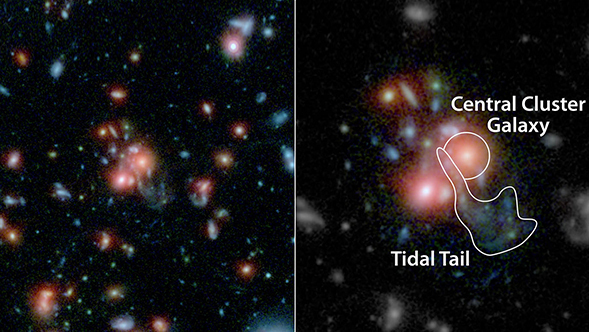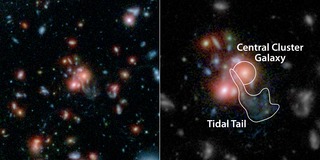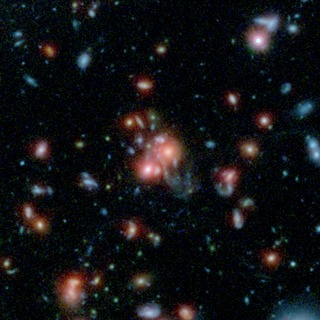
Credit: NASA/ESA/STScI/JPL-Caltech/McGill
Collage • September 10th, 2015 • ssc2015-03a
ssc2015-03a
A massive cluster of galaxies, called SpARCS1049+56, can be seen in this multi-wavelength view from NASA's Hubble and Spitzer space telescopes. At the middle of the picture is the largest, central member of the family of galaxies (upper right red dot of central pair). Unlike other central galaxies in clusters, this one is bursting with the birth of new stars.
Scientists say this star birth was triggered by a collision between a smaller galaxy and the giant, central galaxy. The smaller galaxy's wispy, shredded parts, called a tidal tail, can be seen coming out below the larger galaxy. Throughout this region are features called "beads on a string," which are areas where gas has clumped to form new stars.
The right panel highlights the central galaxy and tidal tail.
This type of "feeding" mechanism for galaxy clusters -- where gas from the merging of galaxies is converted to new stars -- is rare.
The Hubble data in this image show infrared light with a wavelength of 1 micron in blue, and 1.6 microns in green. The Spitzer data show infrared light of 3.6 microns in red.
About the Object
- Name
- SpARCS1049+56
- Type
- Galaxy > Grouping > Cluster
- Galaxy > Type > Interacting
- Distance
- 9,800,000 Light Years
- Redshift
- 1.7
Color Mapping
| Band | Wavelength | Telescope |
| Infrared | 1.1 µm | Hubble WFC3 |
| Infrared | 1.6 µm | Hubble WFC3 |
| Infrared | 3.6 µm | Spitzer IRAC |
Astrometrics
- Position (J2000)
- RA =10h 49m 22.7s
- Dec = 56° 40' 31.4"
- Field of View
- 0.8 x 0.8 arcminutes
- Orientation
- North is up






